Lignin-Based Admixtures: A Scientometric Analysis and Qualitative Discussion Applied to Cement-Based Composites
Abstract
1. Introduction
1.1. Characteristics of Technical Lignins
1.2. Lignosulfonate-Based Admixtures
1.3. Research Aim
2. Methodology
2.1. Search Tools
2.2. Bibliometric Search
2.3. Scientometric Analysis
2.4. Qualitative Analysis
3. Results
3.1. Annual Publication Trend
3.2. Analysis of Publication Sources
3.3. Co-Occurrence Network of Keywords Analysis
3.4. Co-Authorship Network Analysis
3.5. Active Countries in the LBA Research
3.6. Relevant Terms in the LBAs Research
4. Qualitative Discussion
4.1. Development of New LBAs and Their Influence on Workability
4.2. Other Properties of New LBAs
4.2.1. Influence on Setting Time and Air Entrainment
4.2.2. Influence on Mechanical Properties
4.3. Knowledge Gaps and Considerations for Further Research
5. Conclusions
- Most research has focused on developing LBAs using modified and unmodified Kraft lignins. The use of other technical lignins must be better understood to expand and diversify the LBAs research;
- The use of lignins obtained in biorefinery processes and residual black liquors is a viable alternative to consolidate emerging economies in LBAs research. In addition, incorporating LBAs jointly with residual mineral admixtures is an important step toward more sustainable practices in the construction industry;
- LBAs can be classified as plasticizers, superplasticizers, air-entraining agents, and set retarders. The LBAs developed so far were applied mainly in ordinary cement-based composites. In this sense, there is a lack of studies focusing on the incorporation of LBAs in special concrete and mortar (e.g., UHPC and lightweight concrete);
- Most research focused on the production processes and chemical characterization of LBAs. However, the evaluation of the mechanical and physical properties of LBA-containing composites needs more attention in further research since unwanted side effects of LBAs may affect the matrix-hardened properties.
Author Contributions
Funding
Institutional Review Board Statement
Data Availability Statement
Acknowledgments
Conflicts of Interest
References
- Yaqoob, A.A.; Sekeri, S.H.; Othman, M.B.H.; Ibrahim, M.N.M.; Feizi, Z.H. Thermal degradation and kinetics stability studies of oil palm (Elaeis guineensis) biomass-derived lignin nanoparticle and its application as an emulsifying agent. Arab. J. Chem. 2021, 14, 103182. [Google Scholar] [CrossRef]
- Kun, D.; Pukánszky, B. Polymer/lignin blends: Interactions, properties, applications. Eur. Polym. J. 2017, 93, 618–641. [Google Scholar] [CrossRef]
- Bajwa, D.S.; Pourhashem, G.; Ullah, A.H.; Bajwa, S.G. A concise review of current lignin production, applications, products and their environment impact. Ind. Crop. Prod. 2019, 139, 111526. [Google Scholar] [CrossRef]
- Sekeri, S.H.; Ibrahim, M.N.M.; Umar, K.; Yaqoob, A.A.; Azmi, M.N.; Hussin, M.H.; Othman, M.B.H.; Malik, M.F.I.A. Preparation and characterization of nanosized lignin from oil palm (Elaeis guineensis) biomass as a novel emulsifying agent. Int. J. Biol. Macromol. 2020, 164, 3114–3124. [Google Scholar] [CrossRef] [PubMed]
- Eraghi Kazzaz, A.; Fatehi, P. Technical lignin and its potential modification routes: A mini-review. Ind. Crop. Prod. 2020, 154. [Google Scholar] [CrossRef]
- El Mansouri, N.E.; Salvadó, J. Structural characterization of technical lignins for the production of adhesives: Application to lignosulfonate, kraft, soda-anthraquinone, organosolv and ethanol process lignins. Ind. Crop. Prod. 2006, 24, 8–16. [Google Scholar] [CrossRef]
- Laurichesse, S.; Avérous, L. Chemical modification of lignins: Towards biobased polymers. Prog. Polym. Sci. 2014, 39, 1266–1290. [Google Scholar] [CrossRef]
- Upton, B.M.; Kasko, A.M. Strategies for the conversion of lignin to high-value polymeric materials: Review and perspective. Chem. Rev. 2016, 116, 2275–2306. [Google Scholar] [CrossRef]
- Strassberger, Z.; Tanase, S.; Rothenberg, G. The pros and cons of lignin valorisation in an integrated biorefinery. RSC Adv. 2014, 4, 25310–25318. [Google Scholar] [CrossRef]
- Budnyak, T.M.; Slabon, A.; Sipponen, M.H. Lignin–Inorganic Interfaces: Chemistry and Applications from Adsorbents to Catalysts and Energy Storage Materials. ChemSusChem 2020, 13, 4344–4355. [Google Scholar] [CrossRef]
- Aïtcin, P.-C. High Performance Concrete; E-book; Taylor & Francis: London, UK, 1998; ISBN 0-203-47503-8. [Google Scholar]
- He, W.; Fatehi, P. Preparation of sulfomethylated softwood kraft lignin as a dispersant for cement admixture. RSC Adv. 2015, 5, 47031–47039. [Google Scholar] [CrossRef]
- Dessbesell, L.; Paleologou, M.; Leitch, M.; Pulkki, R.; Charles, C. Global lignin supply overview and kraft lignin potential as an alternative for petroleum-based polymers. Renew. Sustain. Energy Rev. 2020, 123, 109768. [Google Scholar] [CrossRef]
- Li, S.; Li, Z.; Zhang, Y.; Liu, C.; Yu, G.; Li, B.; Mu, X.; Peng, H. Preparation of Concrete Water Reducer via Fractionation and Modification of Lignin Extracted from Pine Wood by Formic Acid. ACS Sustain. Chem. Eng. 2017, 5, 4214–4222. [Google Scholar] [CrossRef]
- Kajaste, R.; Hurme, M. Cement industry greenhouse gas emissions—Management options and abatement cost. J. Clean. Prod. 2016, 112, 4041–4052. [Google Scholar] [CrossRef]
- Bribián, I.Z.; Capilla, A.V.; Usón, A.A. Life cycle assessment of building materials: Comparative analysis of energy and environmental impacts and evaluation of the eco-efficiency improvement potential. Build. Environ. 2011, 46, 1133–1140. [Google Scholar] [CrossRef]
- Magina, S.; Barros-Timmons, A.; Evtuguin, D.V. Synthesis of lignosulfonate-based dispersants for application in concrete formulations. Materials 2021, 14, 7388. [Google Scholar] [CrossRef]
- Zheng, T.; Zhong, D.; Zheng, D.; Bao, F.; Zheng, J.; Qiu, X. Kraft lignin grafted with isopentenol polyoxyethylene ether and the dispersion performance. Int. J. Biol. Macromol. 2020, 150, 1147–1154. [Google Scholar] [CrossRef]
- Moreira, P.H.S.S.; de Oliveira Freitas, J.C.; Braga, R.M.; Araújo, R.M.; de Souza, M.A.F. Production of carboxymethyl lignin from sugar cane bagasse: A cement retarder additive for oilwell application. Ind. Crop. Prod. 2018, 116, 144–149. [Google Scholar] [CrossRef]
- Zheng, D.; Zheng, T.; Chen, R.; Li, X.; Qiu, X. Amination of black liquor and the application in the ready-mixed wet mortar. Environ. Technol. 2018, 39, 44–50. [Google Scholar] [CrossRef]
- Pang, Y.; Qiu, X.; Yang, D.; Lou, H. Influence of oxidation, hydroxymethylation and sulfomethylation on the physicochemical properties of calcium lignosulfonate. Colloids Surf. A Physicochem. Eng. Asp. 2008, 312, 154–159. [Google Scholar] [CrossRef]
- Yu, G.; Li, B.; Wang, H.; Liu, C.; Mu, X. Preparation of concrete superplasticizer by oxidation- sulfomethylation of sodium lignosulfonate. BioResources 2013, 8, 1055–1063. [Google Scholar] [CrossRef]
- Konduri, M.K.; Kong, F.; Fatehi, P. Production of carboxymethylated lignin and its application as a dispersant. Eur. Polym. J. 2015, 70, 371–383. [Google Scholar] [CrossRef]
- Ouyang, X.; Ke, L.; Qiu, X.; Guo, Y.; Pang, Y. Sulfonation of Alkali Lignin and its potential use in dispersant for cement. J. Dispers. Sci. Technol. 2009, 30, 1–6. [Google Scholar] [CrossRef]
- Zhang, T.; Gao, J.; Qi, B.; Liu, Y. Performance of concrete made with superplasticizer from modified black liquor and polycarboxylate. BioResources 2014, 9, 7352–7362. [Google Scholar] [CrossRef]
- Calvo-Flores, F.G.; Dobado, J.A. Lignin as renewable raw material. ChemSusChem 2010, 3, 1227–1235. [Google Scholar] [CrossRef]
- El-mekkawi, S.A.; Ismail, I.M.; El-attar, M.M.; Fahmy, A.A.; Mohammed, S.S. Utilization of black liquor as concrete admixture and set retarder aid. J. Adv. Res. 2011, 2, 163–169. [Google Scholar] [CrossRef]
- Takahashi, S.; Hattori, M.; Morimoto, M.; Uraki, Y.; Yamada, T. Performance of softwood soda-anthraquinone lignin as water-reducing chemical admixture in concrete. J. Wood Chem. Technol. 2014, 34, 31–38. [Google Scholar] [CrossRef]
- Safian, M.T.U.; Sekeri, S.H.; Yaqoob, A.A.; Serrà, A.; Jamudin, M.D.; Ibrahim, M.N.M. Utilization of lignocellulosic biomass: A practical journey towards the development of emulsifying agent. Talanta 2022, 239, 123109. [Google Scholar] [CrossRef]
- Ragauskas, A.J.; Beckham, G.T.; Biddy, M.J.; Chandra, R.; Chen, F.; Davis, M.F.; Davison, B.H.; Dixon, R.A.; Gilna, P.; Keller, M.; et al. Lignin valorization: Improving lignin processing in the biorefinery. Science 2014, 344, 1246843. [Google Scholar] [CrossRef]
- Huang, C.; Ma, J.; Zhang, W.; Huang, G.; Yong, Q. Preparation of lignosulfonates from biorefinery lignins by sulfomethylation and their application as a water reducer for concrete. Polymers 2018, 10, 841. [Google Scholar] [CrossRef]
- Gadhave, R.V.; Mahanwar, P.A.; Gadekar, P.T. Lignin-Polyurethane Based Biodegradable Foam. Open J. Polym. Chem. 2018, 8, 1–10. [Google Scholar] [CrossRef]
- Vishtal, A.; Kraslawski, A. Challenges in industrial applications of technical lignins. BioResources 2011, 6, 3547–3568. [Google Scholar] [CrossRef]
- Aro, T.; Fatehi, P. Production and Application of Lignosulfonates and Sulfonated Lignin. ChemSusChem 2017, 10, 1861–1877. [Google Scholar] [CrossRef] [PubMed]
- Deng, Y.; Zhang, W.; Wu, Y.; Yu, H.; Qiu, X. Effect of Molecular Weight on the Adsorption Characteristics of Lignosulfonates. J. Phys. Chem. 2011, 115, 14866–14873. [Google Scholar] [CrossRef]
- Meighan, B.N.; Lima, D.R.S.; Cardoso, W.J.; Baêta, B.E.L.; Adarme, O.F.H.; Santucci, B.S.; Pimenta, M.T.B.; de Aquino, S.F.; Gurgel, L.V.A. Two-stage fractionation of sugarcane bagasse by autohydrolysis and glycerol organosolv delignification in a lignocellulosic biorefinery concept. Ind. Crop. Prod. 2017, 108, 431–441. [Google Scholar] [CrossRef]
- Sivagurunathan, P.; Raj, T.; Mohanta, C.S.; Semwal, S.; Satlewal, A.; Gupta, R.P.; Puri, S.K.; Ramakumar, S.S.V.; Kumar, R. 2G waste lignin to fuel and high value-added chemicals: Approaches, challenges and future outlook for sustainable development. Chemosphere 2021, 268, 129326. [Google Scholar] [CrossRef]
- Collepardi, M.M. Water Reducers/Retarders. In Concrete Admixtures Handbook: Properties, Science and Technology, 2nd ed.; Ramachandran, V.S., Ed.; Noyes Publications: Park Ridge, IL, USA, 1995; ISBN 0815513739. [Google Scholar]
- Arel, H.Ş.; Aydin, E. Effects of Ca-, Mg-, K-, and Na-lignosulfonates on the behavior of fresh concrete. Constr. Build. Mater. 2017, 157, 1084–1091. [Google Scholar] [CrossRef]
- Arel, H.Ş. The effect of lignosulfonates on concretes produced with cements of variable fineness and calcium aluminate content. Constr. Build. Mater. 2017, 131, 347–360. [Google Scholar] [CrossRef]
- Mehta, P.; Monteiro, P.J.M. Concrete: Microestructure, Properties and Materials, 2nd ed.; IBRACON: São Paulo, Brazil, 2014; ISBN 978-85-98576-21-3. [Google Scholar]
- Lange, A.; Plank, J. Contribution of non-adsorbing polymers to cement dispersion. Cem. Concr. Res. 2016, 79, 131–136. [Google Scholar] [CrossRef]
- Neville, A.M. Properties of Concrete, 5th ed.; Bookman: Porto Alegre, Brazil, 2016; ISBN 9780273755807. [Google Scholar]
- Chen, J.; Kazzaz, A.E.; AlipoorMazandarani, N.; Feizi, Z.H.; Fatehi, P. Production of flocculants, adsorbents, and dispersants from lignin. Molecules 2018, 23, 868. [Google Scholar] [CrossRef]
- Jędrzejczak, P.; Collins, M.N.; Jesionowski, T.; Klapiszewski, Ł. The role of lignin and lignin-based materials in sustainable construction—A comprehensive review. Int. J. Biol. Macromol. 2021, 187, 624–650. [Google Scholar] [CrossRef] [PubMed]
- Hood, W.W.; Wilson, C.S. The literature of bibliometrics, scientometrics, and informetrics. Scientometrics 2001, 52, 291–314. [Google Scholar] [CrossRef]
- Hosseini, M.R.; Martek, I.; Zavadskas, E.K.; Arashpour, M.; Chileshe, N.; Aibinu, A.A. Critical evaluation of off-site construction research: A Scientometric analysis. Autom. Constr. 2018, 87, 235–247. [Google Scholar] [CrossRef]
- Xu, Y.; Zeng, J.; Chen, W.; Jin, R.; Li, B.; Pan, Z. A holistic review of cement composites reinforced with graphene oxide. Constr. Build. Mater. 2018, 171, 291–302. [Google Scholar] [CrossRef]
- Chen, W.; Jin, R.; Xu, Y.; Wanatowski, D.; Li, B.; Yan, L.; Pan, Z.; Yang, Y. Adopting recycled aggregates as sustainable construction materials: A review of the scientific literature. Constr. Build. Mater. 2019, 218, 483–496. [Google Scholar] [CrossRef]
- Jin, R.; Gao, S.; Cheshmehzangi, A.; Aboagye-nimo, E. A holistic review of off-site construction literature published between 2008 and 2018. J. Clean. Prod. 2018, 202, 1202–1219. [Google Scholar] [CrossRef]
- Aghaei Chadegani, A.; Salehi, H.; Md Yunus, M.M.; Farhadi, H.; Fooladi, M.; Farhadi, M.; Ale Ebrahim, N. A comparison between two main academic literature collections: Web of science and scopus databases. Asian Soc. Sci. 2013, 9, 18–26. [Google Scholar] [CrossRef]
- Van Eck, N.J.; Waltman, L. Visualizing Bibliometric Networks. In Measuring Scholarly Impact: Methods and Practice; Ding, Y., Rosseau, R., Wolfram, D., Eds.; Springer: Cham, Switzerland, 2014; pp. 285–320. ISBN 9783319103778. [Google Scholar]
- Van Eck, N.J.; Waltman, L. VOSviewer Manual: Manual for VOSviewer Version 1.6.16; Leiden University: Leiden, The Netherlands, 2020. [Google Scholar]
- Wuni, I.Y.; Shen, G.Q.P.; Osei-Kyei, R. Scientometric review of global research trends on green buildings in construction journals from 1992 to 2018. Energy Build. 2019, 190, 69–85. [Google Scholar] [CrossRef]
- Zhang, B.; Ahmad, W.; Ahmad, A.; Aslam, F.; Joyklad, P. A scientometric analysis approach to analyze the present research on recycled aggregate concrete. J. Build. Eng. 2022, 46, 103679. [Google Scholar] [CrossRef]
- Ammad, S.; Alaloul, W.S.; Saad, S.; Qureshi, A.H. Personal protective equipment (PPE) usage in construction projects: A scientometric approach. J. Build. Eng. 2021, 35, 102086. [Google Scholar] [CrossRef]
- van Eck, N.J.; Waltman, L. Software survey: VOSviewer, a computer program for bibliometric mapping. Scientometrics 2010, 84, 523–538. [Google Scholar] [CrossRef] [PubMed]
- Lou, H.; Lai, H.; Wang, M.; Pang, Y.; Yang, D.; Qiu, X.; Wang, B.; Zhang, H. Preparation of lignin-based superplasticizer by graft sulfonation and investigation of the dispersive performance and mechanism in a cementitious system. Ind. Eng. Chem. Res. 2013, 52, 16101–16109. [Google Scholar] [CrossRef]
- Zheng, T.; Zheng, D.; Qiu, X.; Yang, D.; Fan, L.; Zheng, J. A novel branched claw-shape lignin-based polycarboxylate superplasticizer: Preparation, performance and mechanism. Cem. Concr. Res. 2019, 119, 89–101. [Google Scholar] [CrossRef]
- Gan, L.; Zhou, M.; Yang, D.; Qiu, X. Preparation and Evaluation of Carboxymethylated Lignin as Dispersant for Aqueous Graphite Suspension Using Turbiscan Lab Analyzer. J. Dispers. Sci. Technol. 2013, 34, 644–650. [Google Scholar] [CrossRef]
- Qiu, X.; Zeng, W.; Yu, W.; Xue, Y.; Pang, Y.; Li, X.; Li, Y. Alkyl Chain Cross-Linked Sulfobutylated Lignosulfonate: A Highly Efficient Dispersant for Carbendazim Suspension Concentrate. ACS Sustain. Chem. Eng. 2015, 3, 1551–1557. [Google Scholar] [CrossRef]
- Konduri, M.K.R.; Fatehi, P. Production of water-soluble hardwood kraft lignin via sulfomethylation using formaldehyde and sodium sulfite. ACS Sustain. Chem. Eng. 2015, 3, 1172–1182. [Google Scholar] [CrossRef]
- Konduri, M.K.R.; Fatehi, P. Adsorption and dispersion performance of oxidized sulfomethylated kraft lignin in coal water slurry. Fuel Process. Technol. 2018, 176, 267–275. [Google Scholar] [CrossRef]
- Konduri, M.K.R.; Fatehi, P. Designing anionic lignin based dispersant for kaolin suspensions. Colloids Surf. A Physicochem. Eng. Asp. 2018, 538, 639–650. [Google Scholar] [CrossRef]
- Gupta, C.; Sverdlove, M.J.; Washburn, N.R. Molecular architecture requirements for polymer-grafted lignin superplasticizers. Soft Matter 2015, 11, 2691–2699. [Google Scholar] [CrossRef]
- Gupta, C.; Nadelman, E.; Washburn, N.R.; Kurtis, K.E. Lignopolymer Superplasticizers for Low-CO2 Cements. ACS Sustain. Chem. Eng. 2017, 5, 4041–4049. [Google Scholar] [CrossRef]
- Murray, L.R.; Gupta, C.; Washburn, N.R.; Erk, K.A. Lignopolymers as viscosity-reducing additives in magnesium oxide suspensions. J. Colloid Interface Sci. 2015, 459, 107–114. [Google Scholar] [CrossRef] [PubMed]
- Zheng, D.; Chen, R.; Li, X. Investigation of Grafted Sulfonated Black Liquor as Wet-Ready Mortar Admixture. Environ. Prog. Sustain. Energy 2016, 35, 1395–1399. [Google Scholar] [CrossRef]
- Zhu, S.; Huang, W.; Huang, W.; Wang, K.; Chen, Q.; Wu, Y. Pretreatment of rice straw for ethanol production by a two-step process using dilute sulfuric acid and sulfomethylation reagent. Appl. Energy 2015, 154, 190–196. [Google Scholar] [CrossRef]
- Kalliola, A.; Vehmas, T.; Liitiä, T.; Tamminen, T. Alkali-O2 oxidized lignin—A bio-based concrete plasticizer. Ind. Crop. Prod. 2015, 74, 150–157. [Google Scholar] [CrossRef]
- Magina, S.; Barros-Timmons, A.; Evtuguin, D. V Laccase-catalyzed oxidative modification of lignosulfonates from acidic sulfite pulping of eucalyptus wood. Holzforschung 2020, 74, 589–596. [Google Scholar] [CrossRef]
- Gupta, C.; Perkins, K.M.; Rios, R.T.; Washburn, N.R. Poly(ethylene oxide)-grafted lignosulfonate superplasticisers: Improving performance by increasing steric interactions. Adv. Cem. Res. 2017, 29, 2–10. [Google Scholar] [CrossRef]
- Childs, C.M.; Perkins, K.M.; Menon, A.; Washburn, N.R. Interplay of Anionic Functionality in Polymer-Grafted Lignin Superplasticizers for Portland Cement. Ind. Eng. Chem. Res. 2019, 58, 19760–19766. [Google Scholar] [CrossRef]
- Aso, T.; Koda, K.; Kubo, S.; Yamada, T.; Nakajima, I.; Uraki, Y. Preparation of novel lignin-based cement dispersants from isolated lignins. J. Wood Chem. Technol. 2013, 33, 286–298. [Google Scholar] [CrossRef]
- Takahashi, S.; Hosoya, S.; Hattori, M.; Morimoto, M.; Uraki, Y.; Yamada, T. Performance of softwood soda-anthraquinone lignin-polyethylene glycol derivatives as water-reducing admixture for concrete. J. Wood Chem. Technol. 2015, 35, 348–354. [Google Scholar] [CrossRef]
- Zheng, T.; Zheng, D.; Li, X.; Cai, C.; Lou, H.; Liu, W.; Qiu, X. Synthesis of Quaternized Lignin and Its Clay-Tolerance Properties in Montmorillonite-Containing Cement Paste. ACS Sustain. Chem. Eng. 2017, 5, 7743–7750. [Google Scholar] [CrossRef]
- Li, X.; Zheng, D.; Zheng, T.; Lin, X.; Lou, H.; Qiu, X. Enhancement clay tolerance of PCE by lignin-based polyoxyethylene ether in montmorillonite-contained paste. J. Ind. Eng. Chem. 2017, 49, 168–175. [Google Scholar] [CrossRef]
- Cong, M.; Yuhuan, B.; Bing, C. Preparation and performance of a lignosulfonate—AMPS—itaconic acid graft copolymer as retarder for modified phosphoaluminate cement. Constr. Build. Mater. 2014, 60, 25–32. [Google Scholar] [CrossRef]
- Li, Y.; Zhu, H.; Yang, C.; Zhang, Y.; Xu, J.; Lu, M. Synthesis and super retarding performance in cement production of diethanolamine modified lignin surfactant. Constr. Build. Mater. 2014, 52, 116–121. [Google Scholar] [CrossRef]
- Ji, D.; Luo, Z.; He, M.; Shi, Y.; Gu, X. Effect of both grafting and blending modifications on the performance of lignosulphonate-modified sulphanilic acid-phenol-formaldehyde condensates. Cem. Concr. Res. 2012, 42, 1199–1206. [Google Scholar] [CrossRef]
- Chen, H.; Jiang, L.; Cheng, Y.; Lu, J.; Lv, Y.; Yan, J.; Wang, H. Improving enzymatic hydrolysis efficiency of corncob residue through sodium sulfite pretreatment. Appl. Microbiol. Biotechnol. 2019, 103, 7795–7804. [Google Scholar] [CrossRef]
- Akond, A.U.R.; Lynam, J.G. Deep eutectic solvent extracted lignin from waste biomass: Effects as a plasticizer in cement paste. Case Stud. Constr. Mater. 2020, 13, e00460. [Google Scholar] [CrossRef]
- Zhang, C.; Yang, J.; Fu, J.; Ou, X.; Xie, Y.; Dai, Y.; Lei, J. A new clay-cement composite grouting material for tunnelling in underwater karst area. J. Cent. South Univ. 2019, 26, 1863–1873. [Google Scholar] [CrossRef]
- Klapiszewski, Ł.; Klapiszewska, I.; Ślosarczyk, A.; Jesionowski, T. Lignin-Based Hybrid Admixtures and their Role in Cement Composite Fabrication. Molecules 2019, 24, 3544. [Google Scholar] [CrossRef]
- Klapiszewska, I.; Ślosarczyk, A.; Klapiszewski, Ł.; Jesionowski, T. Production of cement composites using alumina-lignin hybrid materials admixture. Physicochem. Probl. Miner. Process. 2019, 55, 1401–1412. [Google Scholar] [CrossRef]
- Slosarczyk, A.; Klapiszewska, I.; Jedrzejczak, P.; Klapiszewski, Ł.; Jesionowski, T. Biopolymer-Based Hybrids as Effective Admixtures for Cement Composites. Polymers 2020, 12, 1180. [Google Scholar] [CrossRef]
- Klapiszewska, I.; Parus, A.; Ławniczak, Ł.; Jesionowski, T.; Klapiszewski, Ł.; Ślosarczyk, A. Production of antibacterial cement composites containing ZnO/lignin and ZnO–SiO2/lignin hybrid admixtures. Cem. Concr. Compos. 2021, 124, 104250. [Google Scholar] [CrossRef]
- Alwadani, N.; Fatehi, P. Synthetic and lignin-based surfactants: Challenges and opportunities. Carbon Resour. Convers. 2018, 1, 126–138. [Google Scholar] [CrossRef]
- Kamoun, A.; Jelidi, A.; Chaabouni, M. Evaluation of the performance of sulfonated esparto grass lignin as a plasticizer—water reducer for cement. Cem. Concr. Res. 2003, 33, 995–1003. [Google Scholar] [CrossRef]
- Plank, J.; Sachsenhauser, B. Experimental determination of the effective anionic charge density of polycarboxylate superplasticizers in cement pore solution. Cem. Concr. Res. 2009, 39, 1–5. [Google Scholar] [CrossRef]
- Lora, J. Industrial commercial lignins: Sources, properties and applications. In Monomers, Polymers and Composites from Renewable Resources, 1st ed.; Belgacem, M.N., Gandini, A., Eds.; Elsevier: Oxford, UK, 2008; pp. 225–241. ISBN 9780080453163. [Google Scholar]
- Olafusi, O.S.; Sadiku, E.R.; Snyman, J.; Ndambuki, J.M.; Kupolati, W.K. Application of nanotechnology in concrete and supplementary cementitious materials: A review for sustainable construction. SN Appl. Sci. 2019, 1, 580. [Google Scholar] [CrossRef]
- Cui, K.; Chang, J. Hydration, reinforcing mechanism and macro performance of multi-layer graphene-modified cement composites. J. Build. Eng. 2022, 57, 104880. [Google Scholar] [CrossRef]
- Cui, K.; Liang, K.; Chang, J.; Lau, D. Investigation of the macro performance, mechanism, and durability of multiscale steel fiber reinforced low-carbon ecological UHPC. Constr. Build. Mater. 2022, 327, 126921. [Google Scholar] [CrossRef]
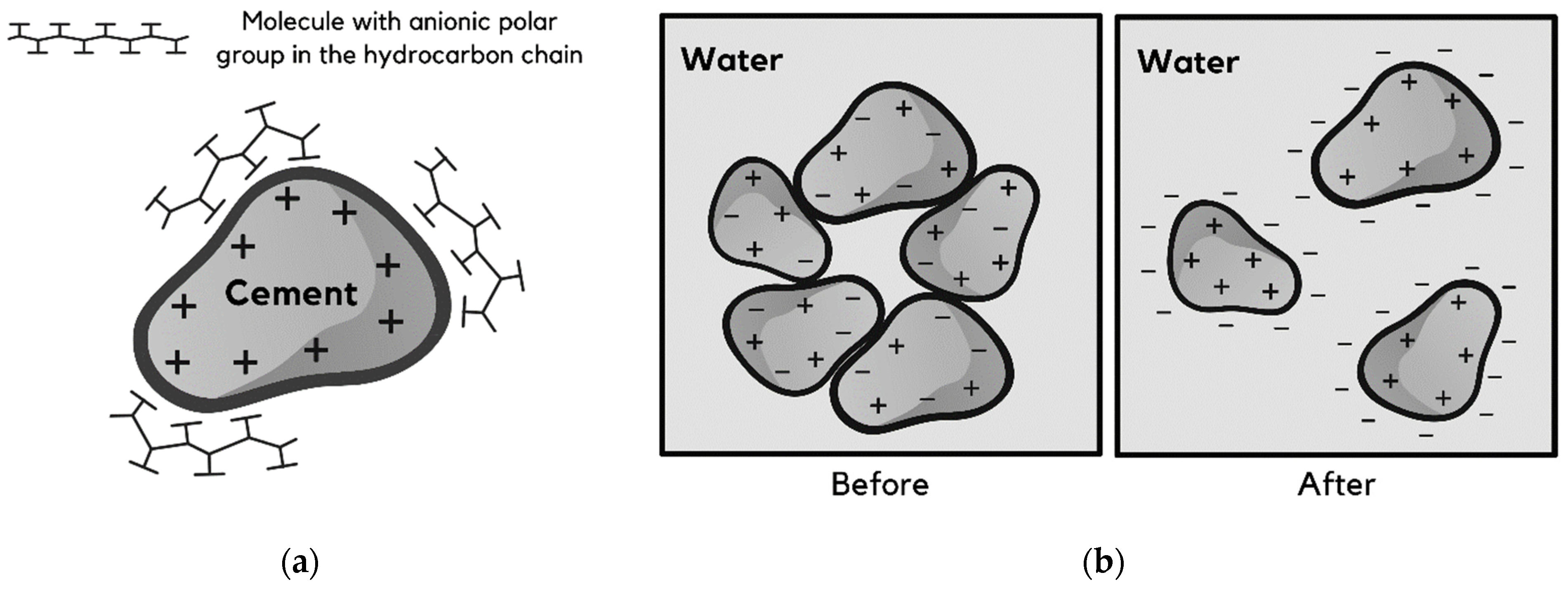
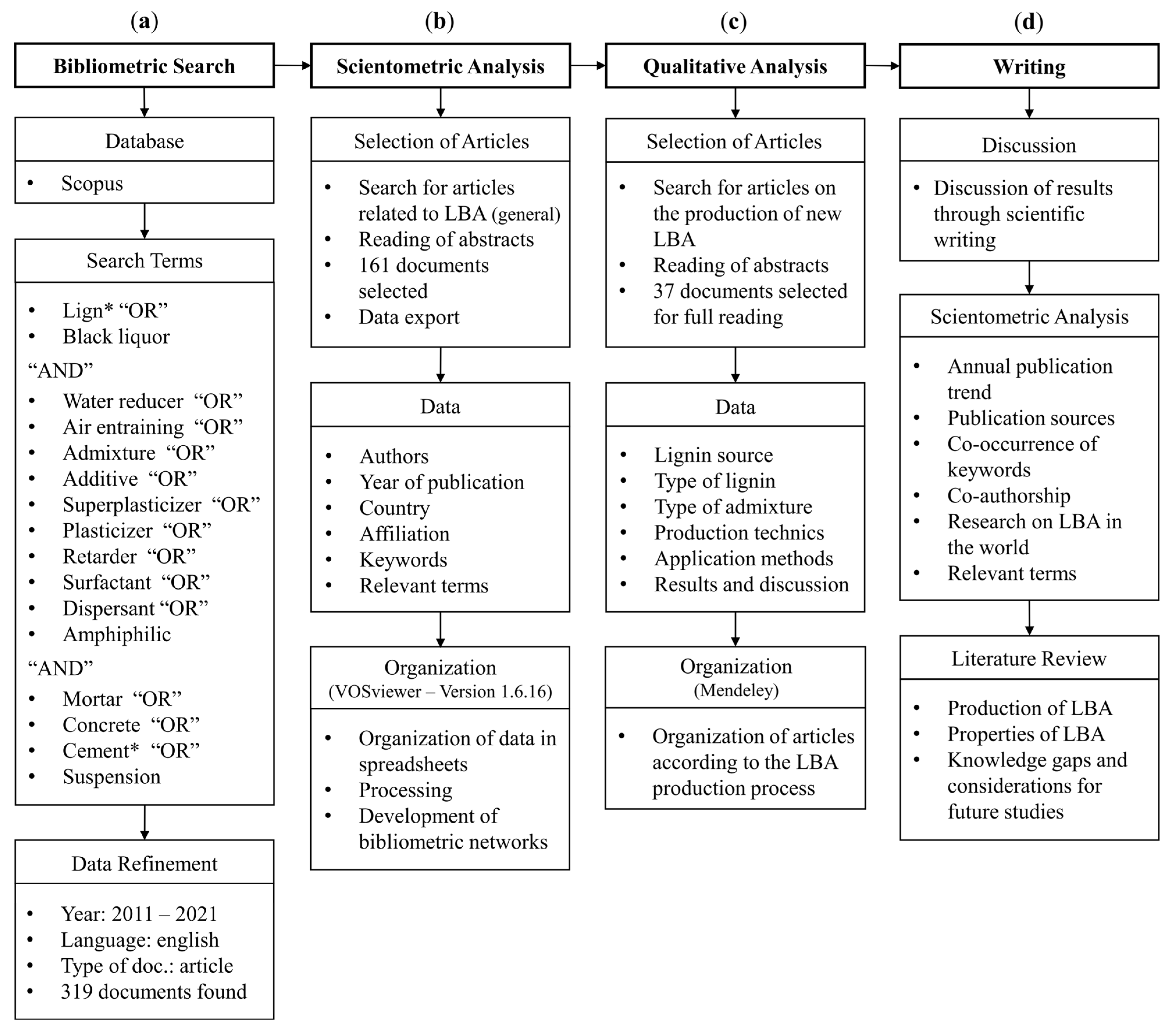
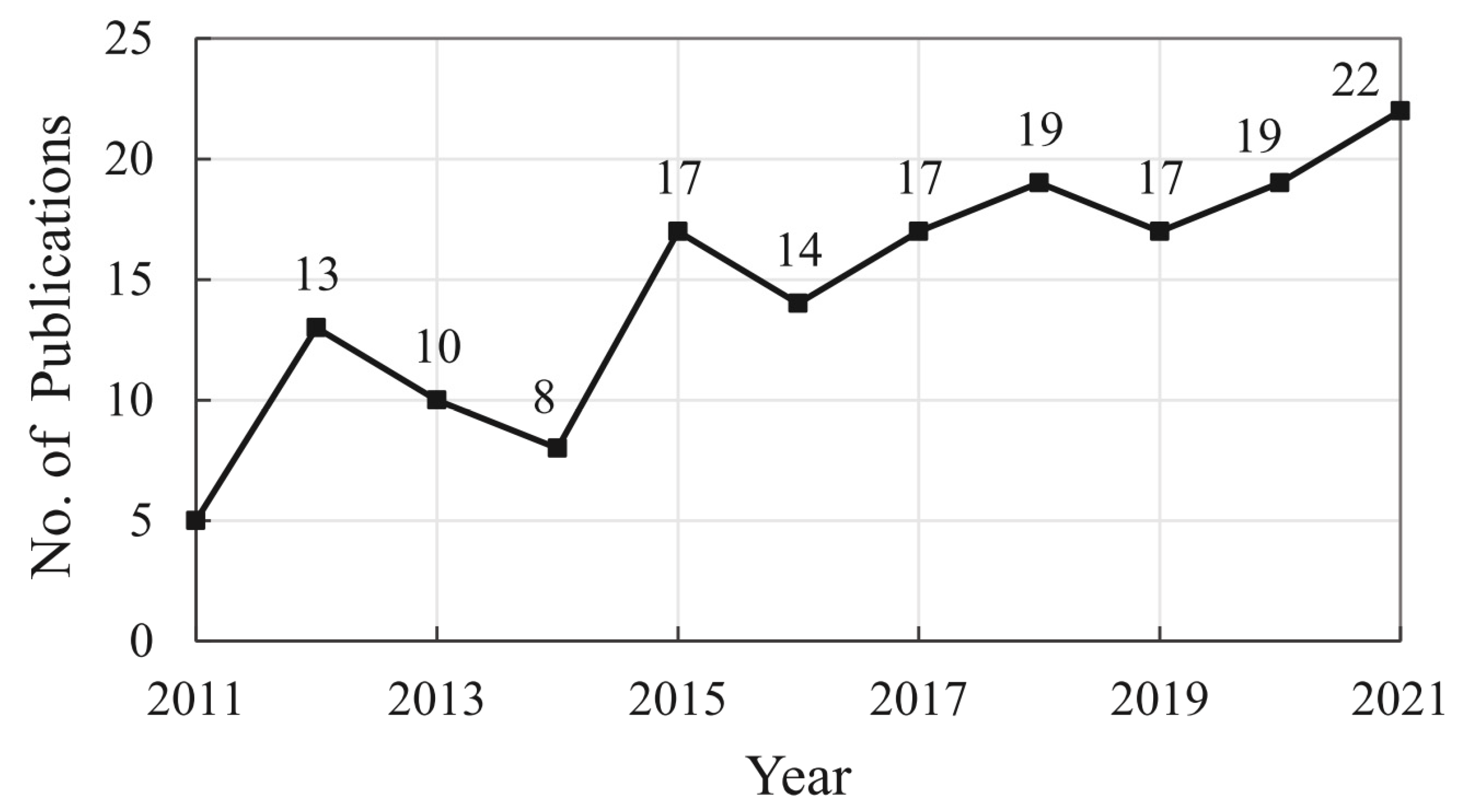

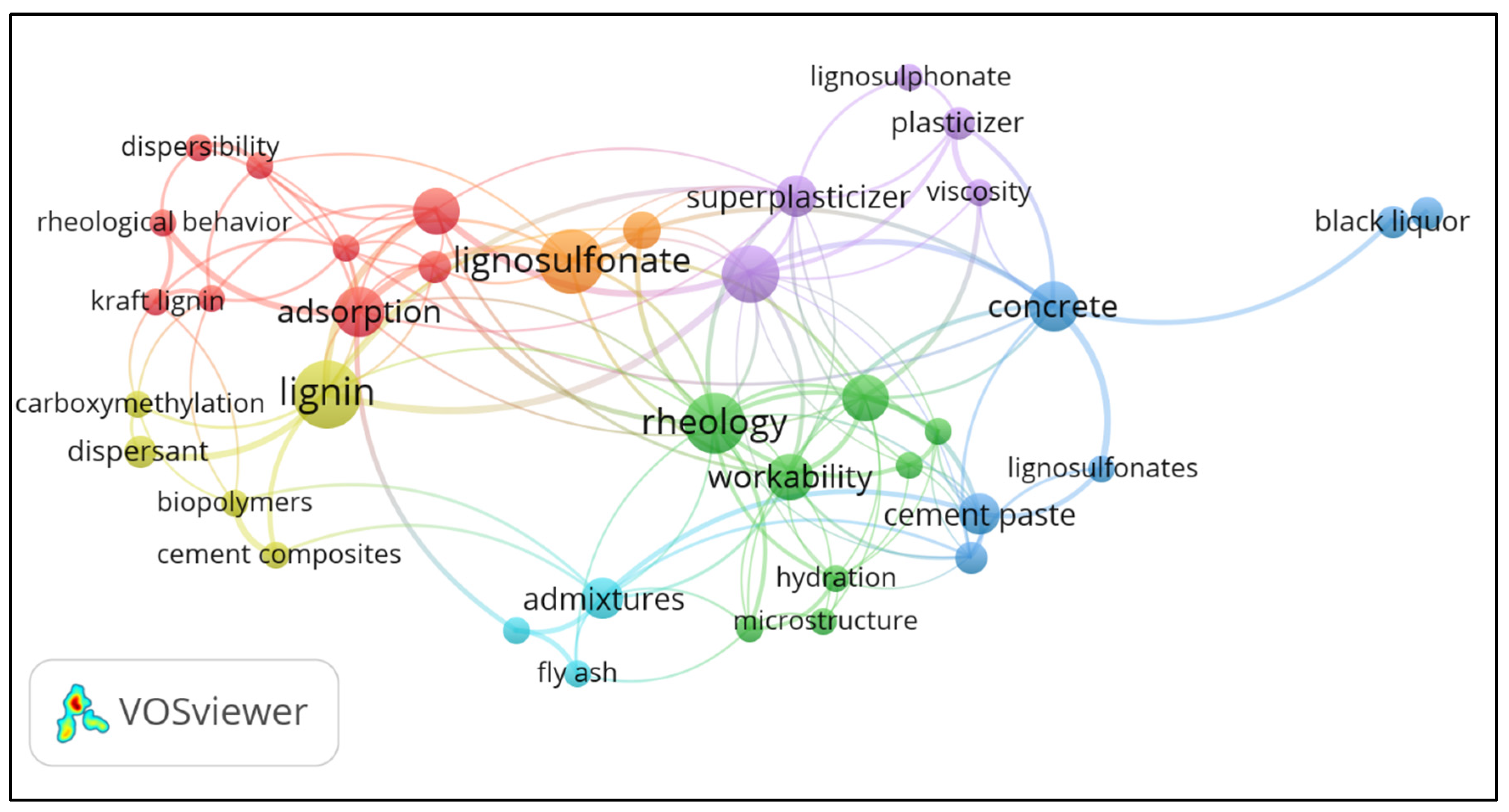
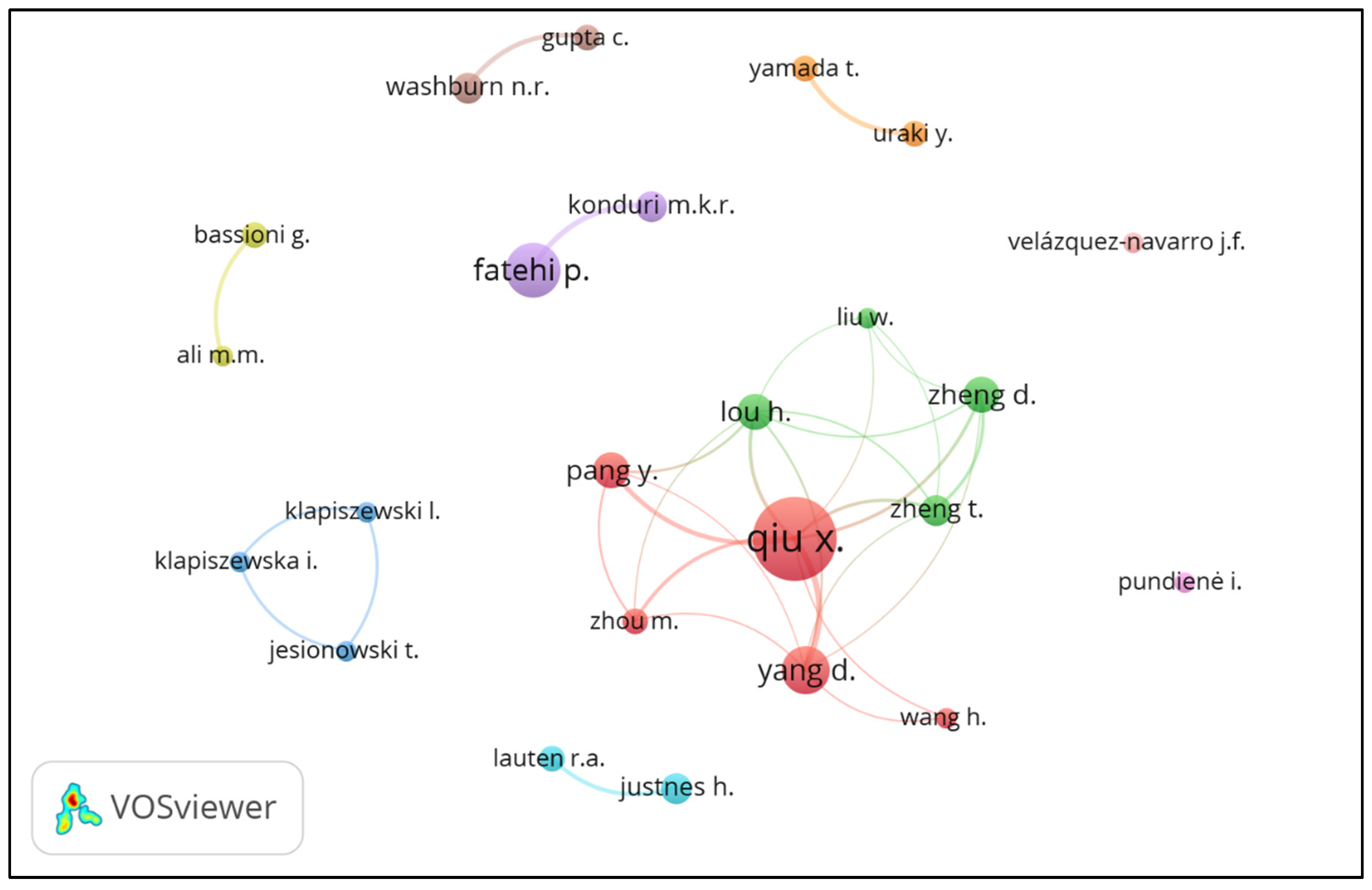

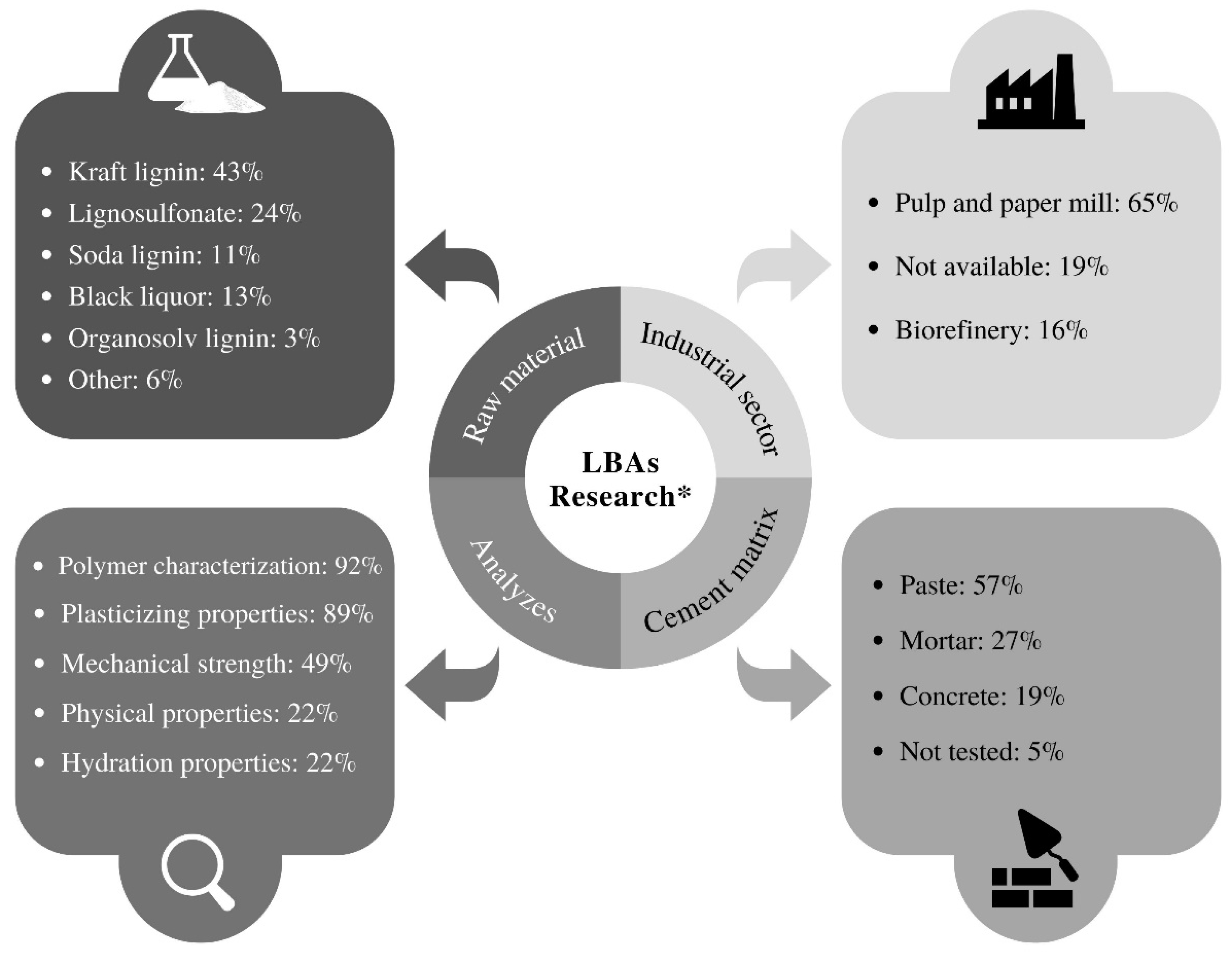
| Journal Source | No. of Articles | Citations | Total Link Strength | Average Citations | Av. Norm. Citations |
|---|---|---|---|---|---|
| Construction and Building Materials | 14 | 292 | 6 | 20.86 | 1.53 |
| Cement and Concrete Research | 10 | 186 | 16 | 18.60 | 1.54 |
| ACS Sustainable Chemistry and Eng. | 9 | 207 | 15 | 23.00 | 1.41 |
| Advances in Cement Research | 8 | 25 | 5 | 3.13 | 0.18 |
| Cement and Concrete Composites | 5 | 330 | 2 | 66.00 | 1.95 |
| Industrial Crops and Products | 4 | 189 | 6 | 47.25 | 1.79 |
| RSC Advances | 4 | 58 | 10 | 14.50 | 1.3 |
| Industrial and Eng. Chemistry Research | 4 | 92 | 12 | 23.00 | 1.19 |
| Polymers | 4 | 45 | 10 | 11.25 | 0.86 |
| Holzforschung | 4 | 48 | 5 | 12.00 | 0.56 |
| Bioresources | 3 | 116 | 3 | 38.67 | 1.87 |
| ACI Materials Journal | 3 | 45 | 0 | 15.00 | 0.77 |
| Journal of Wood Chemistry and Tec. | 3 | 47 | 2 | 15.67 | 0.67 |
| Keyword | Occurrences | Total Link Strength |
|---|---|---|
| Rheology | 11 | 10 |
| Cement * | 10 | 9 |
| Lignin * | 13 | 9 |
| Concrete * | 8 | 8 |
| Adsorption | 8 | 7 |
| Lignosulfonate * | 12 | 7 |
| Admixture * | 7 | 6 |
| Dispersion | 7 | 6 |
| Superplasticizer * | 6 | 6 |
| Workability | 7 | 6 |
| Admixtures * | 6 | 5 |
| Cement paste * | 6 | 5 |
| Plasticizer * | 4 | 4 |
| Superplasticizers * | 4 | 4 |
| Biopolymers | 3 | 3 |
| Author | Publications | Citations | Average Citations | Av. Norm. Citations | Total Link Strength |
|---|---|---|---|---|---|
| Qiu X. | 20 | 336 | 16.80 | 0.97 | 19 |
| Fatehi P. | 11 | 268 | 24.36 | 1.41 | 5 |
| Yang D. | 9 | 208 | 23.11 | 1.29 | 9 |
| Lou H. | 6 | 142 | 23.67 | 1.09 | 6 |
| Pang Y. | 6 | 149 | 24.83 | 1.29 | 6 |
| Zheng D. | 6 | 47 | 7.83 | 0.71 | 5 |
| Justnes H. | 5 | 118 | 23.60 | 1.27 | 3 |
| Konduri M.K.R. | 5 | 154 | 30.80 | 1.62 | 5 |
| Washburn N.R. | 5 | 49 | 9.80 | 0.6 | 4 |
| Zheng T. | 5 | 45 | 9.00 | 0.83 | 5 |
| Bassioni G. | 4 | 17 | 4.25 | 0.21 | 3 |
| Gupta C. | 4 | 46 | 11.50 | 0.64 | 4 |
| Lauten R.A. | 4 | 69 | 17.25 | 1.04 | 3 |
| Uraki Y. | 4 | 57 | 14.25 | 0.55 | 4 |
| Yamada T. | 4 | 57 | 14.25 | 0.55 | 4 |
| Zhou M. | 4 | 64 | 16.00 | 1.21 | 4 |
| Jesionowski T. | 4 | 25 | 6.25 | 0.62 | 3 |
| Klapiszewska I. | 4 | 25 | 6.25 | 0.62 | 3 |
| Klapiszewski L. | 4 | 25 | 6.25 | 0.62 | 3 |
| Ali M.M. | 3 | 17 | 5.67 | 0.28 | 3 |
| Liu W. | 3 | 17 | 5.67 | 0.5 | 1 |
| Pundienė I. | 3 | 24 | 8.00 | 0.6 | 0 |
| Velázquez-Navarro J.F. | 3 | 10 | 3.33 | 1.58 | 0 |
| Wang H. | 3 | 59 | 19.67 | 1.39 | 1 |
| Country | No. of Articles | Citations | Average Citations | Av. Norm. Citations | Total Link Strength |
|---|---|---|---|---|---|
| China | 44 | 765 | 17.39 | 0.98 | 6 |
| USA | 18 | 179 | 9.94 | 0.67 | 6 |
| Canada | 14 | 359 | 25.64 | 1.50 | 6 |
| Spain | 8 | 193 | 24.13 | 1.65 | 0 |
| Egypt | 7 | 55 | 7.86 | 0.76 | 4 |
| Norway | 7 | 129 | 18.43 | 1.02 | 0 |
| Brazil | 6 | 105 | 17.50 | 0.89 | 1 |
| Germany | 6 | 70 | 11.67 | 0.47 | 3 |
| Turkey | 6 | 52 | 8.67 | 0.72 | 2 |
| Lithuania | 5 | 29 | 5.80 | 0.41 | 0 |
| Australia | 4 | 285 | 71.25 | 1.90 | 1 |
| India | 4 | 29 | 7.25 | 0.31 | 0 |
| Japan | 4 | 57 | 14.25 | 0.55 | 0 |
| France | 3 | 123 | 41.00 | 1.59 | 2 |
| United Arab Emirates | 3 | 17 | 5.67 | 0.28 | 3 |
| Terms | Occurrences | Relevance Score |
|---|---|---|
| FTIR | 10 | 4.7954 |
| Molecular weight | 21 | 4.4322 |
| Kraft Lignin * | 17 | 4.0542 |
| Dispersant * | 28 | 3.5232 |
| Suspension * | 28 | 3.3739 |
| Modification | 16 | 2.7296 |
| Preparation | 14 | 2.5526 |
| Zeta Potential | 20 | 2.3811 |
| Hydration | 22 | 1.5207 |
| Lignin * | 58 | 1.4878 |
| Application | 28 | 1.4509 |
| Mechanical property | 14 | 1.4308 |
| Yield Stress | 10 | 1.1772 |
| Compressive strength | 20 | 1.0535 |
| Polycarboxylate | 25 | 0.9914 |
| Plasticizer * | 18 | 0.9477 |
| Workability | 18 | 0.8347 |
| Cement * | 54 | 0.8315 |
| Strength | 26 | 0.7787 |
| Rheology | 19 | 0.7197 |
| Lignin Type and Source | Molecular Weight (g/mol) | Classification | Modification Method | Mineral Admixtures | Dosages | Ref. |
|---|---|---|---|---|---|---|
| Kraft lignin isolated from wheat straw pulping black liquor | 25,700 | Superplasticizer | Sulfonation | None | 0.2, 0.3, 0.4, 0.5, 0.6, 0.8, and 1.0 wt.% of cement | [58] |
| Alkaline lignin from the pretreatment of bamboo residues | 15,470 | Plasticizer | Sulfomethylation | Not available | 0.1, 0.2, 0.4, 0.6, and 0.8 wt.% of cement | [31] |
| Hardwood Kraft lignin | 53,360 | Plasticizer | Sulfomethylation | Not available | 1.0 wt.% of cement | [62] |
| Black liquor from Soda pulping | 13,200 | Plasticizer | Sulfonation | Fly ash | 0.5, 1.0, 1.5, 2.0, 3.0 wt.% of cement | [68] |
| Not available | Not available | Plasticizer | Sulfomethylation | Not tested | Not tested | [69] |
| Commercial sodium lignosulfonate | 23,650 | Superplasticizer | Oxidation and Sulfomethylation | None | 0.3 wt.% of cement | [22] |
| Pinewood Organosolv lignin | 15,000 to 22,000 | Plasticizer | Oxidation and Sulfomethylation | None | 0.3 wt.% of cement | [14] |
| Softwood Kraft lignin | 18,299 | Superplasticizer | Oxidation and Sulfomethylation | None | 0.2, 0.3, 0.4, 0.5 wt.% of cement | [12] |
| Wheat straw Soda lignin | 3200 to 7320 | Plasticizer | Oxidation by O2 in alkaline conditions | None | 0.4 wt.% of cement | [70] |
| Magnesium lignosulfonate | 36,800 | Plasticizer | Laccase-catalyzed oxidative treatment | Not tested | Not tested | [71] |
| Kraft lignin | Not available | Superplasticizer | Controlled radical polymerization using polyacrylamide | Kaolin clay and clinoptilolite zeolite | 0.5 and 5 mg/mL or 0.025, and 0.25 wt.%, respectively | [66] |
| Kraft lignin | Not available | Superplasticizer | Controlled radical polymerization using polyacrylamide | None | 0.025, 0.05, 0.1, 0.15, 0.2, and 0.25 wt.% of cement | [65] |
| Kraft lignin and sodium lignosulfonate | 10,000 | Superplasticizer | Controlled radical polymerization using polyacrylamide | Simulation of cement paste with magnesium oxide suspensions | 0.25 and 2.7 mg/mL | [67] |
| Commercial sodium lignosulfonate | 20,000 | Superplasticizer | Polymerization using poly(ethylene oxide) | None | 0.3, 0.4, and 0.5 wt.% of cement | [72] |
| Kraft lignin and commercial sodium lignosulfonate | 2300 to 3880 | Superplasticizer | Radical polymerization using poly(methacrylic acid) and poly(3-sulfopropyl methacrylate) | None | 0.25 wt.% of cement | [73] |
| Pinewood Kraft lignin | 149,100 to 192,200 | Superplasticizer | Polymerization using poly(ethylene oxide) | None | 0.07, 0.09, 0.11, 0.13, and 0.15 wt.% of cement | [59] |
| Pinewood Kraft lignin | 7400 to 22,300 | Superplasticizer | Polymerization using poly(ethylene oxide) | None | 0.1 and 0.5 wt.% of cement | [18] |
| Kraft lignin and black liquor from hardwood and softwood Kraft pulping | Above 3000 | Plasticizer | Modifications using poly(ethylene glycol) derivatives | None | 0.2, 0.4, 0.6, and 0.8 wt.% of cement | [74] |
| Soda lignin isolated from Japanese cedar pulping black liquor | 3600 to 9100 | Plasticizer | No modification | None | 0.2, 0.4, and 0.6 wt.% of cement | [28] |
| Soda lignin isolated from Japanese cedar pulping black liquor | Not available | Plasticizer | Modifications using Poly(ethylene glycol) derivatives | None | 0.2, 0.4, 0.6, 0.8, and 1.2 wt.% of cement | [75] |
| Purified lignosulfonate from acid magnesium-based sulfite pulping of eucalyptus | 3240 | Plasticizer | Different modification methods, including modifications with poly(ethylene glycol) and poly(propylene glycol) derivatives | None | 2.5 wt.% of cement of an admixture solution containing 40 wt.% solids content | [17] |
| Pinewood lignosulfonate | 12,000 | Anti-Slurry | Quaternization using 3-chloro-2-hydroxypropyl trimethylammonium chloride | Montmorillonite clay | 0.01 wt.% of cement | [76] |
| Pinewood Kraft lignin | 18,700 | Anti-Slurry | Polymerization using polyethylene glycol | Montmorillonite clay | 0.01, 0.02, 0.03, and 0.04 wt.% of cement | [77] |
| Commercial sodium lignosulfonate | Not available | Set retarder | Copolymerization using 2-acrylamido-2-methyl propane sulfonic acid and itaconic acid | None | 0.4, 0.5, 0.6, 0.7, and 0.8 wt.% of cement | [78] |
| Soda lignin isolated from sugarcane bagasse pulping black liquor | Not available | Set retarder | Carboxymethylation | None | 4.68, 8.69, and 13.37 L/m³ (liter per cubic meter of cement) | [19] |
| Not available | Not available | Grinding aid and set retarder | Reaction with diethanolamine | None | 0.01, 0.02, 0.03, 0.04, and 0.05 wt.% of cement | [79] |
| Black liquor from rice straw Soda pulping | Not available | Plasticizer and set retarder | No modification | Silica fume | 5, 15, 25, and 35% in replacement of the water volume | [27] |
| Black liquor from sugarcane bagasse alkaline pulping | Not available | Air-entraining | Amination through Mannich reaction | Fly ash | 0.1, 0.2, 0.3, 0.4, and 0.5 wt.% of cement | [20] |
| Commercial sodium lignosulfonate | 24,180 to 31,890 | Superplasticizer | Copolymerization and blending using sulphanilic acid–phenol–formaldehyde condensates | None | 0.6, 0.8, 1.0, and 1.2 wt.% of cement | [80] |
| Black liquor from wheat stalk sulfate pulping | Not available | Superplasticizer | Mixing with polycarboxylate-based superplasticizer and modification processes using polycarboxylate-based superplasticizer, ferrous sulfate, hydrogen peroxide and sodium sulfite | None | 0.35, 0.4, 0.45, and 0.5 wt.% of cement | [25] |
| Lignosulfonate isolated from corncob residue sodium sulfite pretreatment | Not available | Plasticizer | No modification | Not tested | Not tested | [81] |
| Deep eutectic solvent lignins isolated from sugarcane bagasse and coffee chaff | Not available | Plasticizer | No modification/Carboxymethylation | None | 0.3, 2.0, and 4.0 wt.% of cement | [82] |
| Not available | Not available | Plasticizer | No modification | Clay and meta-aluminate | 1.0, 1.5, 2.0, and 3.0 wt.% of cement | [83] |
| Industrial Kraft lignin and commercial magnesium lignosulfonate | 10,000 | Hybrid admixture | High energy milling between the inorganic-organic materials | Alumina | 0.25, 0.5, and 1.0 wt.% of cement, with alumina/lignin ratios of 5, 2, 1, 0.5, and 0.2 (wt./wt.) | [84,85] |
| Industrial Kraft lignin | 10,000 | Hybrid admixture | High energy milling between the inorganic-organic materials | Silica | 0.5 and 1.0 wt.% of cement, with silica/lignin ratios of 5, 2, 1, 0.5, and 0.2 (wt./wt.) | [86] |
| Industrial Kraft lignin | Not available | Hybrid admixture | High energy milling between the inorganic-organic materials | Zinc oxide and Silica | 0.1 wt.% of cement, with zinc oxide/lignin and zinc oxide-silica/lignin ratios of 5,1 and 0.2 (wt./wt.) | [87] |
Disclaimer/Publisher’s Note: The statements, opinions and data contained in all publications are solely those of the individual author(s) and contributor(s) and not of MDPI and/or the editor(s). MDPI and/or the editor(s) disclaim responsibility for any injury to people or property resulting from any ideas, methods, instructions or products referred to in the content. |
© 2023 by the authors. Licensee MDPI, Basel, Switzerland. This article is an open access article distributed under the terms and conditions of the Creative Commons Attribution (CC BY) license (https://creativecommons.org/licenses/by/4.0/).
Share and Cite
Carvalho, V.R.; Costa, L.C.B.; Baeta, B.E.L.; Peixoto, R.A.F. Lignin-Based Admixtures: A Scientometric Analysis and Qualitative Discussion Applied to Cement-Based Composites. Polymers 2023, 15, 1254. https://doi.org/10.3390/polym15051254
Carvalho VR, Costa LCB, Baeta BEL, Peixoto RAF. Lignin-Based Admixtures: A Scientometric Analysis and Qualitative Discussion Applied to Cement-Based Composites. Polymers. 2023; 15(5):1254. https://doi.org/10.3390/polym15051254
Chicago/Turabian StyleCarvalho, Victor Rezende, Laís Cristina Barbosa Costa, Bruno Eduardo Lobo Baeta, and Ricardo André Fiorotti Peixoto. 2023. "Lignin-Based Admixtures: A Scientometric Analysis and Qualitative Discussion Applied to Cement-Based Composites" Polymers 15, no. 5: 1254. https://doi.org/10.3390/polym15051254
APA StyleCarvalho, V. R., Costa, L. C. B., Baeta, B. E. L., & Peixoto, R. A. F. (2023). Lignin-Based Admixtures: A Scientometric Analysis and Qualitative Discussion Applied to Cement-Based Composites. Polymers, 15(5), 1254. https://doi.org/10.3390/polym15051254







